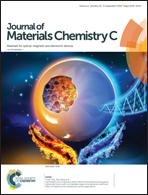Fluorescence modulation by fast photochromism of a [2.2]paracyclophane-bridged imidazole dimer possessing a perylene bisimide moiety†
Abstract
The development of single-molecule imaging and super-resolution microscopy techniques has promoted the study of fluorescence switchable molecules that have been important for the in-depth understanding of the activities of organelles and the geometries of materials in the nano- and microscale. The utilization of photochromic compounds as the photo-switching trigger is an efficient strategy to reversibly control the fluorescent “ON” and “OFF” states. In this study, we demonstrated the red-color fluorescence switching of a perylene bisimide (PBI) derivative by using a fast photochromic [2.2]paracyclophane-bridged imidazole dimer. The transient colored biradical species as the fluorescence quencher is generated upon UV light irradiation. Because the biradical species has broad absorption bands in the whole visible light and the near-infrared regions (500–900 nm), the fluorescence of PBI could be efficiently quenched by Förster resonance energy transfer (FRET). The fluorescence intensity was switched by means of fast photochromic cycles within a few tens of milliseconds. The potential capability of the transient biradical species to switch the fluorescence in the visible and NIR regions will open up new possibilities in multicolor fluorescence imaging.
![Graphical abstract: Fluorescence modulation by fast photochromism of a [2.2]paracyclophane-bridged imidazole dimer possessing a perylene bisimide moiety](/en/Image/Get?imageInfo.ImageType=GA&imageInfo.ImageIdentifier.ManuscriptID=C8TC02713G&imageInfo.ImageIdentifier.Year=2018)


 Please wait while we load your content...
Please wait while we load your content...